
Pinus contorta, with the common names lodgepole pine and shore pine, and also known as twisted pine, and contorta pine, is a common tree in western North America. It is common near the ocean shore and in dry montane forests to the subalpine, but is rare in lowland rain forests. Like all pines, it is an evergreen conifer.
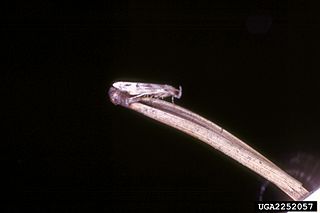
Zelleria haimbachi, the pine needle sheathminer, is a moth of the family Yponomeutidae. In North America it is found from British Columbia south of 52° north latitude, east to Quebec and south to California.
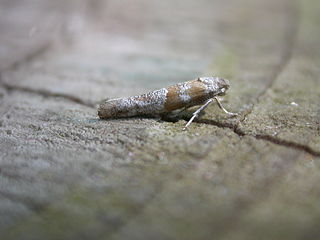
Cedestis gysseleniella is a moth of the family Yponomeutidae. It is found in Europe and parts of Russia.

Protoboarmia porcelaria, the porcelain gray or dash-lined looper, is a Geometrid species of moth found throughout North America, except in the far north. The species was first described by Achille Guenée in 1857.

Blastesthia turionella, the pine bud moth, is a moth of the family Tortricidae. It is found from Europe to eastern Russia, China, Korea and Japan. In the mountains, it occurs to elevations of up to 1,200 meters above sea level.

Clavigesta purdeyi, the pine leaf-mining moth, is a moth of the family Tortricidae. It is found in Belgium, the Netherlands and the United Kingdom.
Rhyacionia duplana, the summer shoot moth or Elgin shoot moth when referring to subspecies logaea, is a moth of the family Tortricidae. It is found from northern and central Europe to eastern Russia, China and Japan. It has also been reported from Korea, but it has not been found in recent studies.
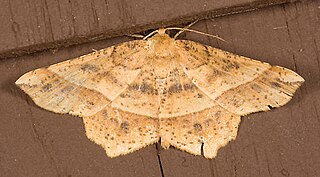
Euchlaena tigrinaria, the mottled euchlaena, is a moth of the family Geometridae. The species was first described by Achille Guenée in 1857. It is found from New Brunswick to Virginia, west to Texas, Utah and Oregon, north to British Columbia.
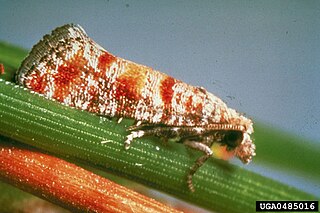
Rhyacionia frustrana, the Nantucket pine tip moth, is a moth of the family Tortricidae. It is found in the United States from Massachusetts south to Florida, west to Missouri, Oklahoma, Texas and California. It is also found in the Dominican Republic, Cuba, Jamaica, Mexico (Oaxaca), Guatemala, Honduras and Nicaragua.

Retinia albicapitana, the northern pitch twig moth, is a moth of the family Tortricidae. In Canada it is found from Nova Scotia to British Columbia and north probably into the southern parts of the Northwest Territories. In the United States, it extends as far south as Montana and the Great Lakes states.

Epinotia radicana, the red-striped needleworm moth, is a species of moth of the family Tortricidae. It is found in western Canada, including British Columbia and the Alberta.
Dioryctria vancouverella is a species of snout moth in the genus Dioryctria. It was described by Mutuura, Munroe & Ross, in 1969, and is known from southern British Columbia, Canada. It is named for the city of Vancouver, from which the type specimen was collected.
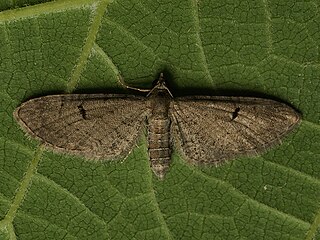
Eupithecia extraversaria is a moth in the family Geometridae. It is found in most of Europe, except Fennoscandia, Estonia, northern Russia, Great Britain and Ireland. It is also found in Iran.

Eupithecia longipalpata is a moth in the family Geometridae. It is found from coastal British Columbia south to California.

Eupithecia placidata is a moth in the family Geometridae first described by Taylor in 1908. It is found in western North America from British Columbia south to California.
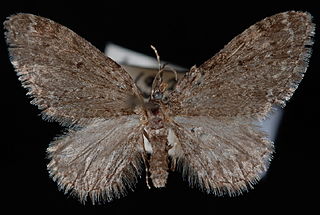
Eupithecia annulata, the larch pug moth, is a moth in the family Geometridae. The species was first described by George Duryea Hulst in 1896. It is found in North America from British Columbia north to the Yukon, east to Newfoundland and Labrador and south to California and Colorado.
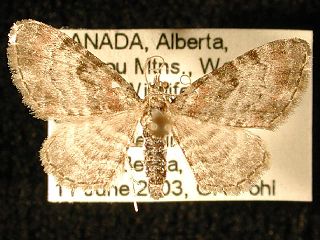
Eupithecia albicapitata is a moth in the family Geometridae. It is found from Newfoundland and Labrador to western British Columbia, north to Alaska and Alberta, south to New England and New York.
Archepandemis coniferana is a species of moth of the family Tortricidae. It is found in North America, where it has been recorded from Alberta, British Columbia and California. The habitat consists of coniferous forests.
Argyrotaenia tabulana, the jack pine tube moth or lodgepole needletier moth, is a species of moth of the family Tortricidae. It is found in North America, where it has been recorded from Alabama, Arkansas, British Columbia, Florida, Georgia, Indiana, Louisiana, Maine, Maryland, Massachusetts, Mississippi, New Jersey, New York, North Carolina, Ohio, Oklahoma, Pennsylvania, South Carolina and West Virginia.
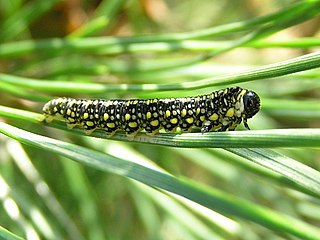
Diprion similis is a species of sawfly in the family Diprionidae. It is native to central and northern Europe and Asia but has been accidentally introduced into North America where it has become invasive. The larvae feed on the needles of pine trees, especially those of the white pine. In North America it is known as the introduced pine sawfly or the imported pine sawfly. It is also known as the white pine sawfly because of its preference for feeding on the white pine, but this name is confusing because another sawfly, Neodiprion pinetum, whose larvae also feed on this tree, is itself known as the "white pine sawfly".
















